Naturally Beethoven
 Les Vents de Montréal / André Moisan; David DQ Lee, contre-ténor; Yannick Nézet-Séguin, piano
Les Vents de Montréal / André Moisan; David DQ Lee, contre-ténor; Yannick Nézet-Séguin, pianoATMA Classique ACD2 3004
***** $
Labels: beethoven, classical CDs, français, product_review, vents
 Les Vents de Montréal / André Moisan; David DQ Lee, contre-ténor; Yannick Nézet-Séguin, piano
Les Vents de Montréal / André Moisan; David DQ Lee, contre-ténor; Yannick Nézet-Séguin, pianoLabels: beethoven, classical CDs, français, product_review, vents
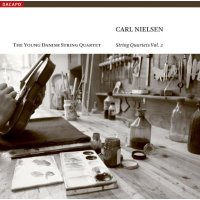 The Young Danish String Quartet
The Young Danish String QuartetLabels: Carl Nielsen, classical CDs, français, product_review
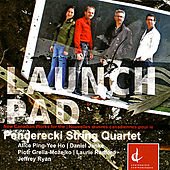 Penderecki String Quartet
Penderecki String QuartetLabels: classical CDs, english, product_review, strings
I can live without the Canadian Memory Fund, and so can you. Cutting PromArt, however, is bad policy. By all means keep it in mind TuesdayKaptainis also takes issue with the $3.8 million for culture.ca:
Another big line item is $3.8 million for culture.ca, an online encyclopedia of Canadian culture broadly defined (wildlife photo galleries, family genealogies and homework tips, as well as arts links). Quite a nifty site, though not something I would expect to gobble so much money. Anyway, you have probably never heard of it.
Her acceptance speech in Montreal after winning the $10,000 Blue Metropolis International Literary Grand Prix in April 2007 was a similar fulmination against the supposedly troglodyte tendencies of the Harper government. That speech came a day or two after the same government announced a $30-million hike to the annual budget of the pre-eminent arts fund, the Canada Council. My impression then was that the great lady was not aware of the news, widely enough reported. My belief now is she does not care.
Labels: arts policy, Election
Labels: contest
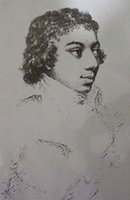
Labels: birthdays, Fernando De Lucia, George Bridgetower, tenor, violin
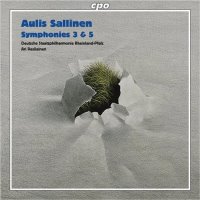 Deutsche Staatsphilharmonie Rheinland-Pfalz / Ari Rasilainen
Deutsche Staatsphilharmonie Rheinland-Pfalz / Ari RasilainenLabels: classical CDs, english, product_review, sallinen
 Un film de Boris Paval Conen et Jiří Kylián
Un film de Boris Paval Conen et Jiří KyliánLabels: Car Men, dvd, français, product_review
Labels: birthdays, composer, Giuseppe Verdi
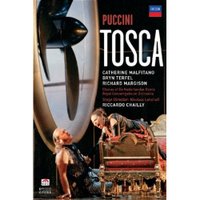 Catherine Malfitano (Floria Tosca), Richard Margison (Mario Cavaradossi), Bryn Terfel (Scarpia), Mario Luperi (Cesare Angelotti), Enrico Fissore (le Sacristain), John Graham-Hall (Spoletta), Jef Van Wersch (Sciarrone), Tom Kemperman (un geôlier), Andreas Burkhart (un berger)
Catherine Malfitano (Floria Tosca), Richard Margison (Mario Cavaradossi), Bryn Terfel (Scarpia), Mario Luperi (Cesare Angelotti), Enrico Fissore (le Sacristain), John Graham-Hall (Spoletta), Jef Van Wersch (Sciarrone), Tom Kemperman (un geôlier), Andreas Burkhart (un berger)Labels: dvd, français, product_review, Puccini
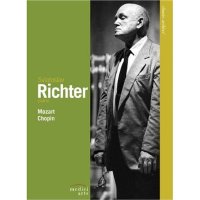 Sviatoslav Richter, piano
Sviatoslav Richter, pianoLabels: dvd, english, piano, product_review, Sviatoslav Richter
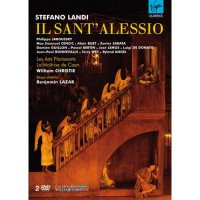 Les Arts Florissants, William Christie
Les Arts Florissants, William ChristieLabels: dvd, français, Landi, product_review
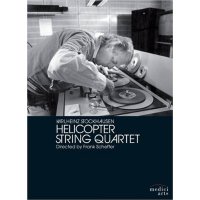 Arditti String Quartet
Arditti String QuartetLabels: dvd, français, Karlheinz Stockhausen, product_review
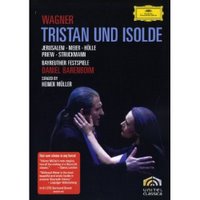 Siegfried Jerusalem (Tristan), Waltraud Meier (Isolde), Mathias Hölle (King Marke), Uta Priew (Brangäne), Poul Elming (Melot)
Siegfried Jerusalem (Tristan), Waltraud Meier (Isolde), Mathias Hölle (King Marke), Uta Priew (Brangäne), Poul Elming (Melot)Labels: dvd, english, product_review, Richard Wagner
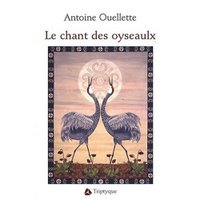 Antoine Ouellette
Antoine OuelletteLabels: book, français, ouellette, product_review
 John Bell Young
John Bell YoungLabels: beethoven, book, english, product_review
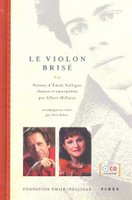 poèmes d’Émile Nelligan choisis et interprétés par Albert Millaire, accompagné au violon par Anne Robert
poèmes d’Émile Nelligan choisis et interprétés par Albert Millaire, accompagné au violon par Anne RobertLabels: book, français, product_review, violin
Labels: birthdays, Camille Saint-Saëns, composer, conductor, organist, piano
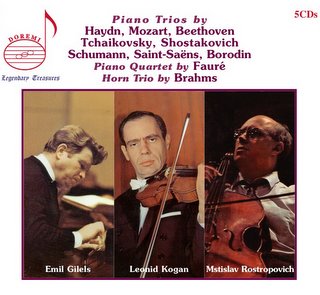 Review by Paul E. Robinson
Review by Paul E. RobinsonLabels: classical CDs, Doremi, Gilels, Kogan, Rostrapovich
In embarking on the 2002 renovation, its owners finally admitted that the RTH acoustics were inferior and engaged one of the best acousticians in the business, the late Russell Johnson, to fix them. Had Johnson been hired at the building design stage, many of the problems would have been avoided. Unfortunately, coming to the job 'after the fact', he was impossibly handicapped by having to make a silk purse out of a sow’s ear.
The renovation had to be done and was clearly long overdue, but RTH remains a colossal mistake. The owners of the hall embarked on the original building project without knowing what they were doing and stuck the orchestra and the city with an architectural and acoustical turkey. RTH literature (“The enhancement project altered the hall, while at the same time honoured and revalued Arthur Erickson’s original design.”) suggests they are still oblivious to the damage they have done.
The 2002 renovations certainly improved RTH, but it is still far from a great concert hall. The sound has much more presence than it did and the upper strings don’t sound computer generated, but they don’t have much body or warmth either. The lower strings sound as bland and undernourished as ever.
If Roy Thomson Hall remains a disappointment, it has at least become a tolerable place in which to hear and to make music; as such, it is far more successful than Salle Wilfred-Pelletier at Place des Arts in Montreal.
Paul E. Robinson is the author of Herbert von Karajan: the Maestro as Superstar and Sir Georg Solti: his Life and Music, both available at http://www.amazon.com/. For more about Paul E. Robinson please visit his website at http://www.theartoftheconductor.com/
Photos by Marita
Labels: classical music, conductors, Kurt Weill, Oundjian, Toronto Symphony, Ute Lemper
Labels: birthdays, cello, Charles Dutoit, conductor, Yo-Yo Ma
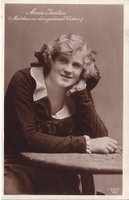 Wikipedia
WikipediaLabels: birthdays, Maria Jeritza, singer
As long as Zeljko Lucic and Nadja Michael take the lead roles as Mr. and Mrs. Mayhem in Munich's new Macbeth, the response will be divided equally between delight and disgust. The production has been stirring emotions and drawing a heated response from audiences and critics.
Delight in Michael's ravishing interpretation of Lady Macbeth, a woman who finds plotting to be an (a)rousing activity. From limber acrobatics in the lowered chandelier to her wildly vibrating yet piercing voice, she played a Lady Macbeth to murder for.
Disgust at the band of extras and chorus members that director Martin Kušej sends downstage to urinate all over the place at the opening of the third act. Choreographed urination is such a clichéd element in European Verdi direction. When 13 topless playboy bunnies with pink wigs appeared shortly after, a smart aleck yelled “bravi”, creating unusual audience merriment for a performance of Macbeth.
At this point, the show was on the verge of being hijacked by the audience; laughter, lusty boos from every tier, and blatant chatter created a casual, irreverent atmosphere rarely encountered in modern opera houses. Slightly rowdy, perhaps, but enjoyable.
As enjoyable as Zelijko Lucic, the Serbian baritone who sang Verdi, his voice ringing effortlessly through the round of the Staatsoper. He out-sang even the very fine Banco of Roberto Scandiuzzi whose severed head would become the play-toy of Lady Macbeth.
And as enjoyable as the homogenously played Bavarian State Orchestra under Nicola Luisotti who got a salvo of boos. His nervous, restless reading that had all the accents in the right places and deserved more bravos than boos.
Kušej (whose Salzburg La Clemenza di Tito is my measure of direction excellence) and his stage designer Martin Zehetgruber created many fine views: including the vast field of skulls and the walls of plastic sheets (á la Guy Ritchie’s “Snatch”).
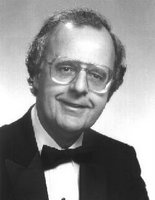 Wikipedia
WikipediaLabels: birthdays, choral conductor, Iwan Edwards